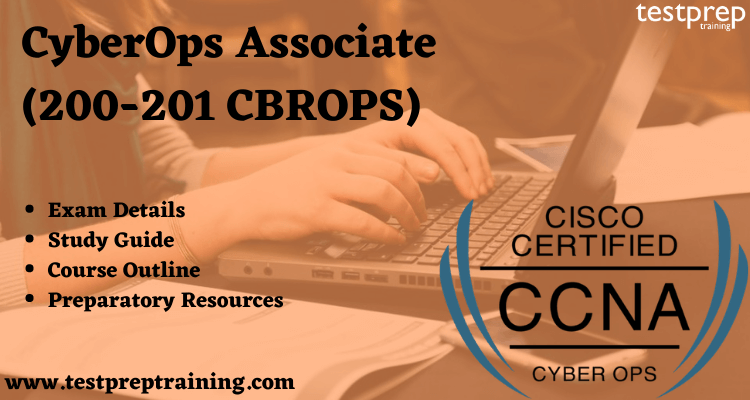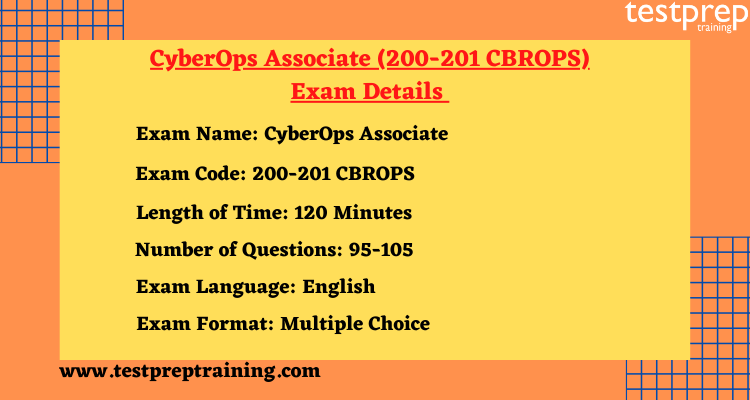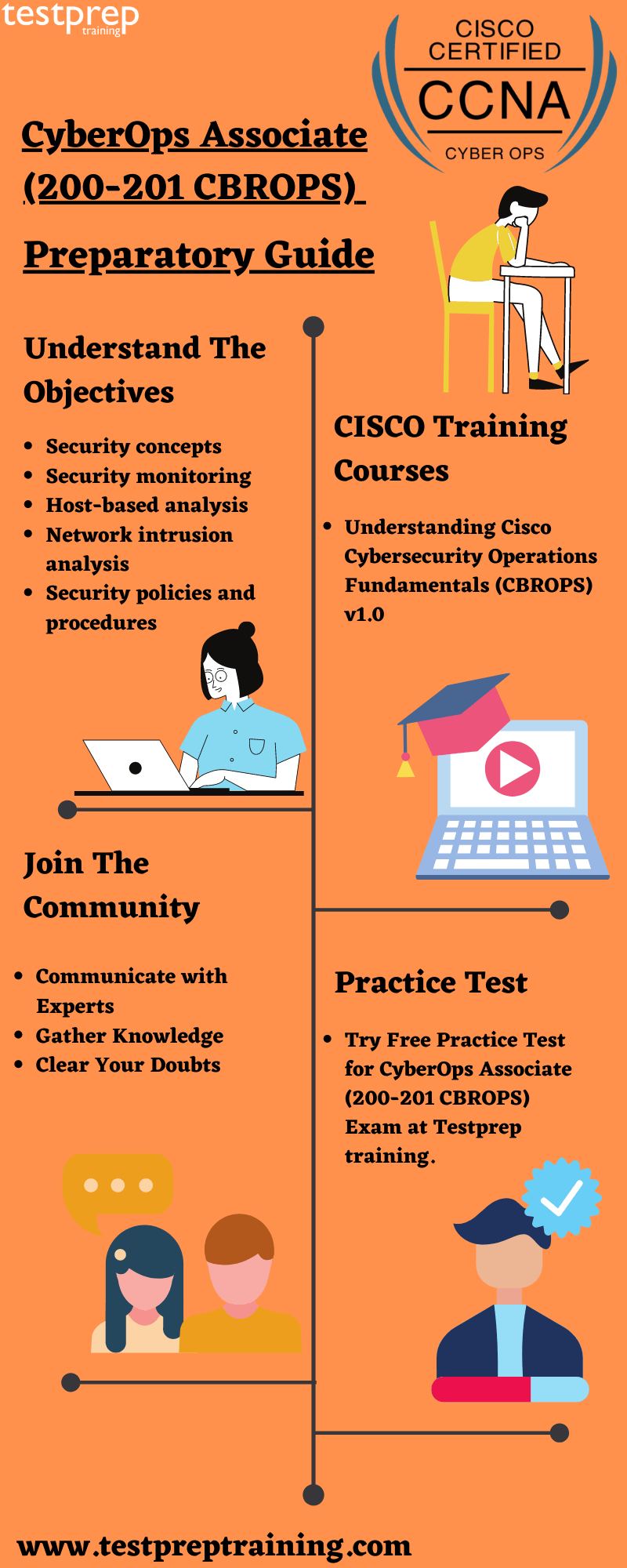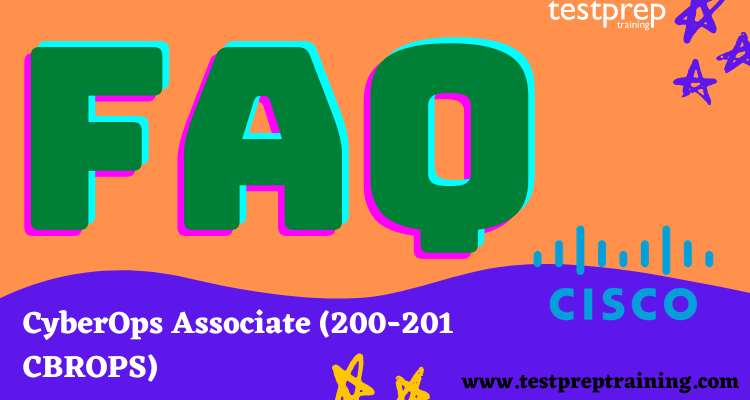CyberOps Associate (200-201 CBROPS)

The Cisco Cybersecurity Operations Fundamentals (200-201 CBROPS) exam is a 120-minute assessment that is associated with the Cisco Certified CyberOps Associate certification. The CBROPS exam tests a candidate’s knowledge and skills related to security concepts, security monitoring, host-based analysis, network intrusion analysis, and security policies and procedures. The course, Understanding Cisco Cybersecurity Operations Fundamentals, helps candidates to prepare for this exam.
This exam tests your knowledge and skills related to:
- Security concepts
- Security monitoring
- Host-based analysis
- Network intrusion analysis
- Security policies and procedures
Who should take this exam?
- For anyone who wishes to gain a practical skillset in mitigating the risk from, malware, Trojans, hackers, tracker, cybercriminals and all online threats.
- For anyone studying for the Cisco CyberOps Associate CBROPS 200-201 certification exam.
Learning Path
Cisco offers a number of certifications in various fields. There are many levels of certifications in Cisco such as entry, associate, specialist, professional, expert, architect. Each level incorporated many certifications in it.
Exam Details
The CyberOps Associate (200-201 CBROPS) exam is present in the English language. The exam has a total of 95-105 questions and 120 minutes will be given to solve the questions. Further, the candidate can register their exam on the Pearson VUE.

To schedule your exam
- Log into your account at Pearson VUE.
- Select Proctored Exams and enter the exam number, 200-201.
- Follow the prompts to register.
Clarify your doubts with CISCO CyberOps Associate (200-201 CBROPS) FAQ
CyberOps Associate (200-201 CBROPS) Course Outline
CISCO has divided the syllabus into various sections. The CyberOps Associate (200-201 CBROPS) exam includes its objectives and sub-topics in it. The detailed course outline is mentioned below:
Domain 1: Security concepts
1.1 Describe the CIA triad
1.2 Compare security deployments
- Network, endpoint, and application security systems (Cisco Reference: Cisco Next-Generation Endpoint Security
- Agentless and agent-based protections
- Legacy antivirus and antimalware (Cisco Reference: Advanced Malware Protection (AMP))
- SIEM, SOAR, and log management (Cisco Reference: Security Platform)
1.3 Describe security terms
- Threat intelligence (TI) (Cisco Reference: Cyber Threat Intelligence)
- Threat hunting (Cisco Reference: Threat Hunting)
- Malware analysis (Cisco Reference: Cisco Advanced Malware Protection Solution Overview)
- Threat actor
- Run book automation (RBA)
- Reverse engineering
- Sliding window anomaly detection
- Principle of least privilege
- Zero trust (Cisco Reference: Cisco Zero Trust Security)
- Threat intelligence platform (TIP)
1.4 Compare security concepts
- Risk (risk scoring/risk weighting, risk reduction, risk assessment)
- Threat (Cisco Reference: Cybersecurity, Common Cyber Attacks)
- Vulnerability (Cisco Reference: Network Security)
- Exploit (Cisco Reference: Network Security Concepts and Policies)
1.5 Describe the principles of the defense-in-depth strategy (Cisco Reference: Security Principles)
1.6 Compare access control models
- Discretionary access control
- Mandatory access control
- Nondiscretionary access control
- Authentication, authorization, accounting (Cisco Reference: Authentication Authorization and Accounting Configuration Guide)
- Rule-based access control
- Time-based access control
- Role-based access control (Cisco Reference: Configuring Role-Based Access Control)
1.7 Describe terms as defined in CVSS
Cisco Reference: Common Vulnerability Scoring System
- Attack vector
- Attack complexity
- Privileges required
- User interaction
- Scope
1.8 Identify the challenges of data visibility (network, host, and cloud) in detection
1.9 Identify potential data loss from provided traffic profiles
1.10 Interpret the 5-tuple approach to isolate a compromised host in a grouped set of logs
1.11 Compare rule-based detection vs. behavioral and statistical detection
Domain 2: Security monitoring
2.1 Compare attack surface and vulnerability
2.2 Identify the types of data provided by these technologies
- TCP dump (Cisco Reference: TCP Dumps)
- NetFlow (Cisco Reference: Introduction to Cisco IOS NetFlow)
- Next-gen firewall (Cisco Reference: Cisco Firewalls)
- Traditional stateful firewall (Cisco Reference: Stateful Firewall Overview)
- Application Visibility and control (Cisco Reference: Cisco Application Visibility and Control (AVC))
- Web content filtering
- Email content filtering
2.3 Describe the impact of these technologies on data visibility
- Access control list (Cisco Reference: IP Named Access Control Lists, IP Access List Overview)
- NAT/PAT (Cisco Reference: PAT)
- Tunneling (Cisco Reference: Implementing Tunnels)
- TOR
- Encryption
- P2P (Cisco Reference: Cisco Application Visibility and Control User Guide)
- Encapsulation
- Load balancing (Cisco Reference: Configuring a Load-Balancing Scheme)
2.4 Describe the uses of these data types in security monitoring
- Full packet capture
- Session data
- Transaction data
- Statistical data
- Metadata
- Alert data
2.5 Describe network attacks, such as protocol-based, denial of service, distributed denial of service, and man-in-the-middle (Cisco Reference: Basic Network Attacks, DDoS Attack)
2.6 Describe web application attacks, such as SQL injection, command injections, and cross-site scripting (Cisco Reference: Understanding SQL Injection, Understanding Cross-Site Scripting (XSS) Threat Vectors)
2.7 Describe social engineering attacks
2.8 Describe endpoint-based attacks, such as buffer overflows, command and control (C2), malware, and ransomware (Cisco Reference: Endpoint Security, Cisco Ransomware Defense)
2.9 Describe evasion and obfuscation techniques, such as tunneling, encryption, and proxies (Cisco Reference: Network IPS Evasion Techniques)
2.10 Describe the impact of certificates on security (includes PKI, public/private crossing the network, asymmetric/symmetric)
2.11 Identify the certificate components in a given scenario
- Cipher-suite (Cisco Reference: SSL Cipher List Configuration Mode Commands)
- X.509 certificates
- Key exchange (Cisco Reference: Configuring Internet Key Exchange for IPsec VPNs)
- Protocol version
- PKCS
Domain 3: Host-based analysis
3.1 Describe the functionality of these endpoint technologies in regard to security monitoring
- Host-based intrusion detection (Cisco Reference: Configuring Host-Based IDS and IPS Devices)
- Antimalware and antivirus (Cisco Reference: Advanced Malware Protection (AMP))
- Host-based firewall
- Application-level allow listing/block listing
- Systems-based sandboxing (such as Chrome, Java, Adobe Reader)
3.2 Identify components of an operating system (such as Windows and Linux) in a given scenario
3.3 Describe the role of attribution in an investigation
- Assets
- Threat actor
- Indicators of compromise (Cisco Reference: Cisco Security Indicators of Compromise Reference Guide)
- Indicators of attack
- Chain of custody
3.4 Identify type of evidence used based on provided logs
- Best evidence
- Corroborative evidence
- Indirect evidence
3.5 Compare tampered and untampered disk image
3.6 Interpret operating system, application, or command line logs to identify an event (Cisco Reference: Identifying Incidents Using Firewall and Cisco IOS Router Syslog Events)
3.7 Interpret the output report of a malware analysis tool (such as a detonation chamber or sandbox)
Cisco Reference: Advanced Malware Protection (AMP)
- Hashes
- URLs
- Systems, events, and networking
Domain 4: Network intrusion analysis
4.1 Map the provided events to source technologies
- IDS/IPS (Cisco Reference: Introducing IDS and IPS)
- Firewall (Cisco Reference: Firewall)
- Network application control
- Proxy logs
- Antivirus (Cisco Reference: Anti-Virus)
- Transaction data (NetFlow) (Cisco Reference: Introduction to Cisco IOS NetFlow)
4.2 Compare impact and no impact for these items
- False positive (Cisco Reference: Options to Reduce False Positive Intrusions)
- False negative (Cisco Reference: Cisco Secure IPS – Excluding False Positive Alarms)
- True positive
- True negative
- Benign
4.3 Compare deep packet inspection with packet filtering and stateful firewall operation (Cisco Reference: Deep Packet Inspection in the Data Center, Stateful Firewall Overview, Cisco Application Visibility and Control (AVC))
4.4 Compare inline traffic interrogation and taps or traffic monitoring
4.5 Compare the characteristics of data obtained from taps or traffic monitoring and transactional data (NetFlow) in the analysis of network traffic (Cisco Reference: Cisco Network Analysis Module)
4.6 Extract files from a TCP stream when given a PCAP file and Wireshark (Cisco Reference: Configuring TCP, Configuring Packet Capture)
4.7 Identify key elements in an intrusion from a given PCAP file
Cisco Reference: Intrusion Detection: Cisco IDS Overview
- Source address
- Destination address
- Source port (Cisco Reference: Understanding and Writing Intrusion Rules)
- Destination port
- Protocols
- Payloads (Cisco Reference: Working with Intrusion Events)
4.8 Interpret the fields in protocol headers as related to intrusion analysis
Cisco Reference: Working with Intrusion Events
- Ethernet frame
- IPv4, IPv6
- TCP, UDP, ICMP
- DNS, SMTP/POP3/IMAP, HTTP/HTTPS/HTTP2 and ARP
4.9 Interpret common artifact elements from an event to identify an alert
- IP address (source / destination) , Client and server port identity
- Process (file or registry) , System (API calls)
- Hashes , URI / URL
4.10 Interpret basic regular expressions (Cisco Reference: Regular Expression Reference)
Domain 5: Security policies and procedures
5.1 Describe management concepts
- Asset management (Cisco Reference: Cisco Asset Management Service)
- Configuration management (Cisco Reference: Network Configuration Management)
- Mobile device management (Cisco Reference: Mobile Device Management in the Meraki Cloud)
- Patch management
- Vulnerability management (Cisco Reference: Vulnerability Management)
5.2 Describe the elements in an incident response plan as stated in NIST.SP800-61
5.3 Apply the incident handling process (such as NIST.SP800-61) to an event
5.4 Map elements to these steps of analysis based on the NIST.SP800-61
- Preparation
- Detection and analysis
- Containment, eradication, and recovery
- Post-incident analysis (lessons learned)
5.5 Map the organization stakeholders against the NIST IR categories (CMMC, NIST.SP800-61)
Cisco Reference: Cisco and the NIST Cybersecurity Framework
- Preparation
- Detection and analysis
- Containment, eradication, and recovery
- Post-incident analysis (lessons learned)
5.6 Describe concepts as documented in NIST.SP800-86
- Evidence collection order
- Data integrity (Cisco Reference: Cisco Data Protection Solutions)
- Data preservation (Cisco Reference: Managing Data and Collection Retention)
- Volatile data collection
5.7 Identify these elements used for network profiling
- Total throughput
- Session duration
- Ports used
- Critical asset address space
5.8 Identify these elements used for server profiling
- Listening ports (Cisco Reference: TCP and UDP Port Usage Guide)
- Logged in users/service accounts
- Running processes (Cisco Reference: Application Profiling
- Running tasks (Cisco Reference: Application Profiling
- Applications (Cisco Reference: Cisco Application Profiling Service)
5.9 Identify protected data in a network
- PII
- PSI
- PHI
- Intellectual property
5.10 Classify intrusion events into categories as defined by security models, such as Cyber Kill Chain Model and Diamond Model of Intrusion (Cisco Reference: Working with Intrusion Events, Diamond Model of Intrusion Analysis)
5.11 Describe the relationship of SOC metrics to scope analysis (time to detect, time to contain, time to respond, time to control)
Exam Policies
The candidate should visit the CISCO official website for understanding the terms and policies of the CISCO. The exam terms and policies include various important information such as age requirements and policies concerning minors, candidate identification and authentication, rights and responsibilities, Confidentiality and agreements, etc.
Preparation Guide for CyberOps Associate (200-201 CBROPS)
The preparation steps which are essential in order to successfully pass the CyberOps Associate (200-201 CBROPS) exam are:

CISCO Official Website
Visiting the CISCO official website is an important step while preparing for the CyberOps Associate (200-201 CBROPS) exam. The official site offers a lot of reliable information and sources which are very helpful in preparing for the exam. The resources such as study guide, sample papers, whitepapers, documentation, faqs, etc. The candidate can find all such important things on the official page.
CISCO Training Program
Training programs are a very necessary step in the preparation of such exams like CyberOps Associate (200-201 CBROPS). CISCO offers its own training programs on their various examinations and certifications. For the CyberOps Associate (200-201 CBROPS) exam, it offers:
Understanding Cisco Cybersecurity Operations Fundamentals (CBROPS) v1.0
This course will help you:
- Learn the fundamental skills, techniques, technologies, and the hands-on practice necessary to prevent and defend against cyberattacks as part of a SOC team.
- Prepare for the 200-201 Understanding Cisco Cybersecurity Operations Fundamentals (CBROPS) exam which earns the Cisco Certified CyberOps Associate certification.
Books and Guides
The next step in the preparatory guide should be books and study guides. The candidate needs to find those books which are enriched with information. Finding a good book may be a difficult task, but in order to gather the knowledge and skills, the candidate has to find, read and understand. We recommend the followings:
- Cisco CyberOps Associate CBROPS 200-201 Official Cert Guide (Certification Guide) 1st Edition by Omar Santos
- CCNA Routing and Switching Certification Kit: Exams 100-101, 200-201, 200-120 1st Edition by Todd Lammle, William Tedder.
Join a Study Group
Joining a group study will also be beneficial for the candidate. It will encourage them to do more hard work. Also, studying in the group will help them to stay connected with the other people who are on the same pathway as them. Also, the discussion of such study groups will benefit the students in their exams.
Evaluate yourself with Practice Test
Most importantly, candidates have to try their hands-on practice tests. Practice tests are the one who secures the candidate about their preparation. The practice test will help the candidates to recognize their vulnerable areas so that they can work on them. There are many practice tests available on the internet nowadays, so the candidate can choose which they want.


